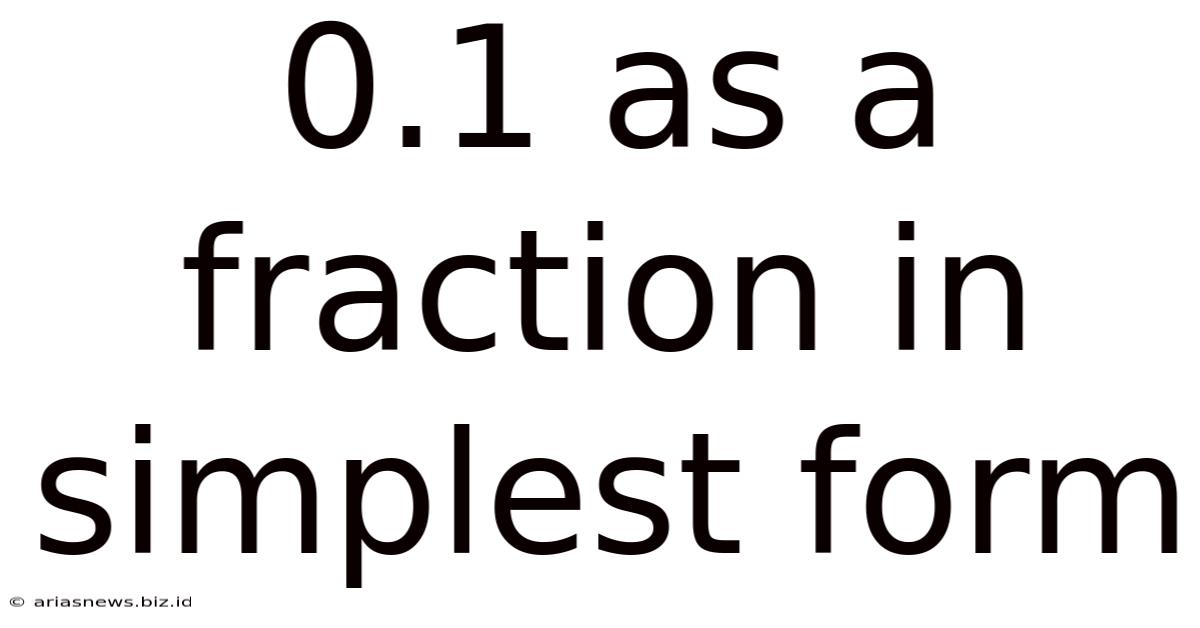0.1 As A Fraction In Simplest Form
Arias News
May 11, 2025 · 5 min read

Table of Contents
0.1 as a Fraction in Simplest Form: A Comprehensive Guide
Decimal numbers are a common way to represent parts of a whole, but sometimes, expressing them as fractions provides a clearer understanding of their value and facilitates mathematical operations. This article delves into the process of converting the decimal 0.1 into its simplest fractional form, exploring the underlying concepts and providing practical examples to solidify your understanding. We'll cover different methods, address common misconceptions, and even explore the broader implications of decimal-to-fraction conversions.
Understanding Decimals and Fractions
Before diving into the conversion, let's refresh our understanding of decimals and fractions.
Decimals: Representing Parts of a Whole
Decimals are a way of representing numbers that are not whole numbers. They use a base-ten system, where each digit to the right of the decimal point represents a power of ten (tenths, hundredths, thousandths, etc.). For example, 0.1 represents one-tenth, 0.01 represents one-hundredth, and so on.
Fractions: A Different Perspective
Fractions, on the other hand, represent parts of a whole using a numerator (the top number) and a denominator (the bottom number). The numerator indicates the number of parts you have, while the denominator indicates the total number of equal parts the whole is divided into. For instance, 1/2 represents one out of two equal parts, while 3/4 represents three out of four equal parts.
Converting 0.1 to a Fraction: The Step-by-Step Process
The conversion of 0.1 to a fraction is relatively straightforward. Here's the method:
Step 1: Write the decimal as a fraction with a denominator of 1.
This is the initial step in converting any decimal to a fraction. We simply write the decimal number as the numerator and place 1 as the denominator:
0.1/1
Step 2: Multiply the numerator and denominator by a power of 10 to eliminate the decimal point.
Since there is one digit after the decimal point in 0.1, we multiply both the numerator and the denominator by 10<sup>1</sup> (which is 10):
(0.1 * 10) / (1 * 10) = 1/10
This step effectively shifts the decimal point one place to the right, resulting in a whole number in the numerator.
Step 3: Simplify the fraction (if possible).
In this case, the fraction 1/10 is already in its simplest form. A fraction is in its simplest form when the greatest common divisor (GCD) of the numerator and the denominator is 1. Since 1 and 10 have no common factors other than 1, the fraction cannot be simplified further.
Therefore, the simplest form of 0.1 as a fraction is 1/10.
Alternative Methods and Understanding the Concept
While the above method is the most straightforward, understanding the underlying concept is crucial for tackling more complex decimal-to-fraction conversions.
Understanding Place Value
The decimal 0.1 signifies one-tenth. This directly translates to the fraction 1/10. Understanding place value allows for quick mental conversion of simple decimals like 0.1, 0.01, 0.001, etc.
Using Proportions
You can also approach this using proportions. 0.1 can be expressed as the ratio 0.1:1. To eliminate the decimal, multiply both sides by 10:
1:10
This directly translates to the fraction 1/10.
Applications and Real-World Examples
The conversion of decimals to fractions is vital in numerous applications across various fields:
Mathematics
- Simplifying calculations: In some mathematical operations, fractions are easier to manipulate than decimals. Converting decimals to fractions can simplify complex calculations, especially those involving fractions and mixed numbers.
- Algebra: Solving algebraic equations often requires working with fractions. Converting decimal coefficients into fractions can streamline the solving process.
- Geometry: Calculations involving area, volume, and other geometric properties often involve fractions. Converting decimal measurements into fractions helps to maintain accuracy.
Everyday Life
- Cooking: Recipes often use fractions to indicate ingredient quantities. If a recipe calls for 0.1 liters of milk, understanding that it's equivalent to 1/10 of a liter helps with accurate measurement.
- Construction: Construction projects rely on precise measurements. Converting decimal dimensions into fractions ensures accuracy and compatibility with standard measuring tools.
- Finance: Working with percentages often involves converting decimal representations to fractions for easier calculation of interest, discounts, or proportions.
Addressing Common Misconceptions
- Incorrect Simplification: A common mistake is incorrectly simplifying fractions. Remember to find the greatest common divisor (GCD) to ensure the fraction is in its simplest form.
- Decimal Point Placement: Errors often arise from misplacing the decimal point when multiplying the numerator and denominator by a power of 10. Careful attention to detail is crucial.
- Confusion with Percentages: While related, decimals and percentages are distinct. 0.1 is equivalent to 10%, but the fractional representation remains 1/10.
Beyond 0.1: Expanding Your Skills
The principles applied to converting 0.1 to a fraction are applicable to converting any decimal to a fraction. The key steps remain the same: write the decimal as a fraction over 1, multiply to remove the decimal point, and simplify. For example:
- 0.25: (0.25/1) * (100/100) = 25/100 = 1/4
- 0.75: (0.75/1) * (100/100) = 75/100 = 3/4
- 0.666... (recurring decimal): This requires a slightly different approach and leads to the fraction 2/3
Mastering these conversions empowers you to seamlessly navigate various mathematical contexts and real-world situations. It's a fundamental skill with broad applications in academics and beyond. Practice makes perfect! Try converting various decimals to fractions to solidify your understanding and improve your proficiency. The more you practice, the more intuitive this process becomes.
Latest Posts
Related Post
Thank you for visiting our website which covers about 0.1 As A Fraction In Simplest Form . We hope the information provided has been useful to you. Feel free to contact us if you have any questions or need further assistance. See you next time and don't miss to bookmark.